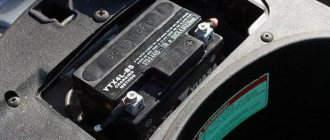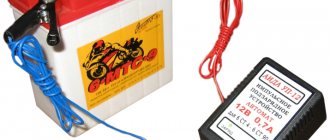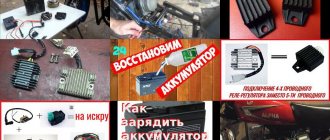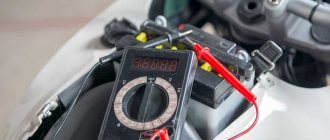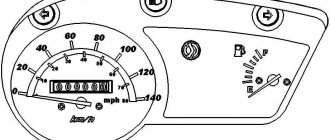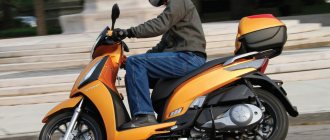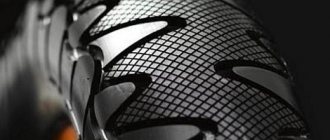Scooter drivers have long become full-fledged participants in traffic in large and small cities. If in winter in the Russian climate it is cold to drive such a vehicle, then in summer there are plenty of them on the streets. Just like a car, a scooter requires a battery. We are talking about a starter battery for starting the engine. The choice of such a battery will be discussed in this article. We will consider the main criteria for choosing a battery for a scooter, types of batteries, lines of some manufacturers, as well as operating requirements.
Which battery is best for a scooter?
Owners of scooters and other motorcycles sooner or later begin to become interested in the question of which battery is better for a scooter - acid or gel.
In stores today you can find a large selection of different batteries of varying power and with different technical characteristics. If you used to buy traditional acid batteries, today you can also buy gel batteries, which came to us from American aviation. The development of scientists allowed aircraft to remain in the air for a long time in different positions. Conventional electrolyte batteries did not meet the high requirements of aviation.
After some time, aviation acquired other methods of storing energy, while gel batteries successfully migrated to motor vehicles. It's not surprising that some scooter owners find themselves stumped in front of store shelves, not knowing which battery to choose.
Before determining which battery is best to put on a scooter, you need to find out how they differ from each other. People unaware of this issue may naively think that there is some kind of gel inside the gel battery.
Actually this is not true. Inside the body there is acid, but with the addition of a thickener that turns the electrolyte into a gel. AGM technology is used. This feature allows the product to be used in various positions.
Even if the case is damaged, it will not have negative consequences. Battery with gel. The thickener will still work, which is basically impossible with a traditional one. In case of cracks in the housing, electrolyte will begin to flow out.
The advantages of a gel battery include the fact that it is the safest battery in the world. In addition, it can be used immediately after purchase. You don't even need to recharge.
Gel batteries can withstand more charge-discharge cycles. This is their significant advantage. If the scooter owner uses them correctly, then such a battery can last much longer than a traditional battery.
True, in practice, instead of the stated seven or ten years, such a battery can last three or four years at most. This depends not only on the handling of the battery, but also on the health of the scooter's electrical equipment.
The gel thickener battery can be used in any position, although upside down is not recommended. Even when working at an incline, power drops by 30%. However, gel batteries are ideal for scooters and other motorcycles.
If the owner is thinking about the question of which battery is best for a 50cc scooter, then he can use both traditional and gel. It depends on personal preferences and the technical condition of the scooter. And at their price, gel batteries are somewhat more expensive than lead-acid batteries. True, the difference is small.
If the owner of a scooter simply loves to ride in winter, then it is better to give preference to a gel battery. The service life of such batteries can be two or three years longer than conventional ones.
It should also be noted that when charging gel batteries, it is necessary to ensure accurate current characteristics, which is not always possible in our conditions. After all, this is a foreign development for foreign consumers. They're fine with tension there!
Another advantage of gel batteries is their ability to provide high starting current! You also need to pay attention to this circumstance when choosing a battery.
One of the main advantages of such a product can rightfully be considered the ability to fully recover even during deep discharge. In the case of lead-acid batteries, this is not possible. Traditional batteries permanently lose part of their capacity when deeply discharged. This circumstance should also be taken into account when purchasing a battery.
If you need to decide which is better to install a battery on a 150cc scooter, then it is better to give preference to a gel one. They are more powerful, reliable and durable. If you drive carefully, you can use a regular battery. If the owner of a scooter loves extreme sports, it is advisable to purchase a gel one. If the housing is damaged, electrolyte will not leak.
You must also remember that in gel batteries the voltage at the terminals during charging is always about 14 volts. Thanks to voltage regulators that supply current to the terminals.
If the battery is discharged, the voltage increases as it charges. This explains the fact that when the battery is discharged, it consumes more energy than it is charged.
It should also be noted that some reputable brand gel batteries can even last 15 years.
In conclusion, I would like to say that the owner himself must choose which battery suits him best. At one time you can drive on lead-acid. Then change to gel and compare their performance.
If the owner needs a reliable battery, then it is better to buy a gel battery from well-known manufacturers.
Batteries for scooter or moped
Now it’s hard to imagine the modern world without maneuverable means of transportation. This is especially true in large cities, where there are long traffic jams during peak hours. This is where maneuverable types of transport such as a scooter or moped come to the rescue; moreover, with a power of up to 50 cubic meters, you can drive without a license. It will go everywhere and will always take its owner to his destination.
Types of batteries for scooters
The following types of scooter batteries are currently being produced.
Sealed battery
Calcium acid batteries
Conventional acid batteries are rarely used in mopeds and scooters, since they do not have a sufficiently reliable rollover protection system. Therefore, as a rule, in modern realities, only sealed battery models made using AGM technology (maintenance-free batteries) are used. The principle of operation of such a battery is quite simple - a chemical reaction of lead dioxide occurs in a sulfuric acid environment with the release of electric current.
Pros of an acid battery:
- Widely popular. Batteries of this type are easily available and have a low price compared to others.
- Stable operation under heavy loads.
- Recyclable.
Disadvantages of an acid battery:
- Reduced power density. Therefore, acid batteries are characterized by increased weight and, therefore, inconvenience of use.
- When the charge is less than 20%, the service life is significantly reduced. Recharging is recommended at 40% charge. This will provide 1500 charge-discharge cycles.
- Be sure to periodically check the electrolyte level and replenish it if there is a deficiency.
- Failure can happen at any time and unexpectedly.
Maintained scooter battery
To achieve maximum performance of a lead acid battery, you must adhere to a number of mandatory rules. The insulation must be in excellent condition and free of leaks. Prevent foreign elements from entering the electrolyte - this will cause delamination of the plates and a decrease in service life. The battery capacity should be checked periodically.
For correct recharging, you need to use a charger with a current in the range of 10% of its total capacity. It is strictly forbidden to use chargers with a higher current strength - otherwise, each recharging cycle will cause irreparable damage to the battery. The charging time of an acid battery directly depends on its capacity.
Acid batteries can be either maintenance-free or maintenance-free; for mopeds and scooters, it is highly recommended to use maintenance-free models.
Gel batteries
The main difference between a gel battery and a regular battery is the gel-like consistency of the acid. And the main advantage is that there is no need for maintenance. With proper operation, the need for service can be completely avoided.
Pros of a gel battery:
- Operation regardless of the position of the battery (standing, on its side, etc.)
- Does not leak even with damaged insulation.
- Increased service life.
- High starting current.
The disadvantages include:
- Overcharging is destructive. Therefore, you need to monitor the battery indication.
- Severe frosts affect service life.
- Increased cost compared to other types of batteries.
Gel batteries are quite unpretentious in service. It is not for nothing that it is classified as maintenance-free. The main rule is not to overexpose it to the cold. If you plan not to use it for a long time, then it is enough to remove it from the moped or scooter in a charged state and store it warm. Due to its low self-discharge ability, a gel battery will only drain by 10-15% in a year.
Charging a gel battery requires special equipment, and not all service centers have such equipment in stock. This is due to the fact that such batteries are quite rare at the moment.
IMPORTANT. When recharging, be sure to observe the voltage level of the electric current. It should not be higher than its threshold. Otherwise, the service life of the battery will be significantly reduced due to delamination of the plates under the influence of the released gas. And since the gel battery is sealed, this can lead to increased pressure inside and a subsequent explosion.
Lithium-ion batteries
The main purpose of such batteries is to use them in racing vehicle models. But they have proven themselves quite well on regular scooters or mopeds. If you follow the operating rules, then this type of battery is safe and does not pose a threat to the environment.
Pros of lithium-ion batteries:
- No memory effect.
- Low self-discharge ability. 10-20% per year.
- The operating temperature range ranges from -20° to +50° Celsius.
- With irregular use, the service life varies within 15-20% per year.
- The service life with proper use exceeds the limit of 10 years.
- Light weight and easy to use.
Cons of lithium-ion batteries:
- High price.
- Overload vulnerability.
- Fear of deep discharges.
- Lithium is a very active element, so if the seal is broken, a fire or explosion may occur.
- Difficulty in recharging at low temperatures.
If you follow the basic rules, lithium-ion scooter batteries will last more than 10 years. To do this, do not leave lithium-ion batteries in a discharged state for a long time. If storing, charge it halfway and place it in a cool, dry place. Do not exceed the recommended charging current. Do not overheat or expose to prolonged frost. It is recommended to completely discharge it once every three months.
Important! When charging a lithium-ion battery, use only the original charger. This is due to the fact that in most cases, part of the charging system is built into the battery itself, and the external network adapter only rectifies the electric current in the household network. Otherwise, the battery life will be significantly reduced.
Which scooters up to 50cc are best to buy: 8 best
In this review, we have collected models of scooters popular in Russia, varying in price and characteristics.
- Honda Dio AF68;
- Suzuki Lets5;
- Yamaha JOG RR;
- Irbis LX50;
- SYM ORBIT50;
- Stels Skif;
- Stels Taktik;
- Racer Meteor RC50QT–3.
Let's look at them in more detail:
Honda Dio AF68
The Japanese scooter first appeared on the market in the 80s of the last century. Today, the fifth generation of the vehicle continues to delight thousands of two-wheeled transport enthusiasts around the world. You can buy a classic for 160 thousand rubles.
According to the owners' reviews, it is unpretentious in maintenance, maneuverable, and economical (1.25 liters per 100 km). Equipped with a 4-stroke engine and a durable frame. The disadvantages include the rather high cost and lack of space for a passenger. Japanese parts, such as piston rings, are also expensive and difficult to obtain.
I've been dreaming about a scooter for a long time. I decided not to save money and buy a quality model. I liked the Honda for its small size and economical fuel consumption. Now I get to work twice as fast.
Honda Dio AF68
Suzuki Lets5
Small in size, maneuverable Japanese with an excellent design. In demand among young people and middle-aged people. It noticeably outperforms its competitor Honda in price - a new one costs 75 thousand rubles. Equipped with a 4-stroke engine, strong frame and excellent brakes. Disadvantages: difficult to find spare parts, dim headlights.
Before buying a Suzuki, I rode a bicycle around the city, became very tired and decided to replace it with a scooter. I was looking for an inexpensive but reliable model. I bought a used Lets5 a couple of weeks ago. While it copes with all the tasks, it drives smoothly and quietly. I hope for Japanese quality and that it will last for many more years.
Suzuki Lets5
Yamaha JOG RR
Rounding out the top three undisputed leaders is another Japanese two-seater scooter. Equipped with a 2-stroke, but no less powerful and reliable engine than its competitors. Frisky and with good handling, holds speed well, designed for two passengers. The disadvantages include the price - 90,000 thousand rubles, expensive spare parts.
Japanese two-wheeled motorized vehicles are legendary, so the choice was obvious. I liked the model because it had a passenger seat and high power. Perhaps problems will arise when parts are needed, I think this will not happen soon.
Yamaha JOG RR
Irbis LX50
A Chinese brand that is very popular among motorcycle enthusiasts due to its aggressive design and advanced equipment. With large dimensions, in comparison with its Japanese counterparts, it easily accelerates to 90 km/h. It can comfortably accommodate 2 people. Disadvantages include a 2-stroke engine and reduced maneuverability. Price – about 60 thousand rubles.
I wanted to buy a simple, powerful and inexpensive scooter. The LX50 fit all the criteria. It holds the road well even with poor quality surfaces. Parts are easy to order from China. Worth the money.
Irbis LX50
SYM ORBIT50
Produced in Taiwan. It has a powerful 4-stroke engine with a consumption of 2–2.5 liters per 100 km. At a price of 60 thousand rubles . Quite comfortable, manageable and rarely prone to breakdowns.
Orbit50 was recommended by a friend. The price suited me, the characteristics also suited me, and I decided to buy it. I drive it a couple of times a week and around the city. Handles the road well and is fairly quiet. There were no breakdowns for a couple of months.
SYM ORBIT50
Stels Skif
Another bright representative of the Chinese automobile industry. For 35 thousand rubles, the buyer receives a maneuverable scooter designed for two people with an acceleration of up to 70 km/h. Due to the rigid suspension, it is designed for driving on asphalt. The disadvantages include frequent breakdowns and increased fuel consumption.
I was looking for the cheapest model. I use it rarely and only in the city. It is convenient to avoid traffic jams. The parts are easy to get, so I don't have to worry about breakages.
Stels Skif
Stels Taktik
A brother of the budget Chinese scooter described above. At a cost of 35–40 thousand rubles . has a 2-stroke engine of 4.9 hp. Weight – 90 kg, quite maneuverable, accelerates to 70 km/h.
Fast and cheap Chinese scooter. Well worth the money. Suitable for the city only. Repairs are inexpensive and accessible.
Stels Taktik
How to choose the right battery for a scooter
When visiting a motorcycle store, always give preference to a battery with rollover protection - this is the most important parameter for a scooter battery. It is also advisable to give preference to models with a stated long service life and high starting current to guarantee successful starting even in extreme cold conditions.
If the choice falls on an acid battery, if possible, choose batteries with AGM technology. They are most resistant to vibration and overturning. The most preferred batteries are 12 volts and a current of 4 amperes/hour. But if necessary, you can choose a more powerful option.
Which memory is better to use?
When purchasing a scooter or moped, it is strongly recommended to read the operating instructions. It describes which batteries are suitable for the selected model and which chargers to use.
Do not try to charge the battery of a charger that is not suitable for this type of battery.
Do you have a scooter or moped? Tell us in the comments what kind of battery you use and how much you like it. This will help make the site content more complete and useful.
Selecting a battery for a scooter and its operation
Scooter drivers have long become full-fledged participants in traffic in large and small cities. If in winter in the Russian climate it is cold to drive such a vehicle, then in summer there are plenty of them on the streets. Just like a car, a scooter requires a battery. We are talking about a starter battery for starting the engine. The choice of such a battery will be discussed in this article. We will consider the main criteria for choosing a battery for a scooter, types of batteries, lines of some manufacturers, as well as operating requirements.
Scooters and mopeds up to 50cc: what to look for when choosing
When choosing a scooter, you should first determine the specific purpose of purchasing a two-wheeled vehicle. Let's look at the main characteristics and differences. Most models are equipped with 2 or 4 stroke engines.
- low noise;
- economical;
- easy to maintain;
- have smaller dimensions and weight, which means they are more maneuverable and suitable for city roads and traffic jams;
- playful and react instantly to squeezing the throttle.
- expensive;
- increased gasoline consumption;
- the need to pour oil directly into the gas tank.
If you love tuning, dynamics and speed, feel free to choose a scooter with this engine. 4-stroke – for people who prefer a quiet riding style.
You should pay attention to the fork installed on the scooter. For trips outside the city and traveling over rough terrain, the optimal and comfortable option is a pendulum fork, and for city trips - a telescopic fork.
The location of the air filter is also important; it quickly becomes dirty when driving on country roads, where there is a lot of dust and will have to be cleaned or replaced frequently.
The choice of any product often depends on the price/quality ratio. What to choose - cheap Chinese, but new, or used Japanese? The decision is yours. If funds allow and you plan to drive constantly, the best option is to buy a model of the Japanese brands Honda, Yamaha or Suzuki.
Choosing a scooter battery
When choosing a battery for a scooter or moped, you need to consider the following points:
- electrical characteristics;
- form factor and design (dimensions, type of terminals, etc.);
- battery type;
- the presence of additional functions that simplify operation (charge indicator);
- brand.
Electrical characteristics
One of the key parameters for choosing a battery is its capacity. The other two electrical specifications are rated voltage and inrush current.
The vast majority of scooter models are equipped with a battery with a nominal voltage of 12 volts and a capacity of 4 to 9 Ah. On sale you can find motorcycle batteries with a capacity of up to 30 Ah. However, models over 15 Ah are usually installed on motorcycles and ATVs with a large engine capacity. The starting current ranges from 20 to 90 amperes. In the case of lithium-ion starter batteries, this value can reach 180 amperes. However, in most cases, this current is not required to start the scooter engine.
The capacity of the scooter battery should be greater, the higher the engine capacity. A similar relationship can be seen between the magnitude of the starting current and the volume of the motor. Return to content
Dimensions and terminals
In the case of scooter batteries, there are significantly more form factors and types of terminals than for car starter batteries. Therefore, the choice here must be made in accordance with the recommendations of the scooter manufacturer or purchase a battery completely similar to the old one. In most cases, the larger the battery's dimensions, the greater its rated capacity. Common sizes include the following:
- 114×39×87, 115×50×86, 120×61×129, 150×86×94, 151×71×107 mm (models with a capacity of up to 9 Ah);
- 150×87×131, 151×71×130, 151×88×147, 207×71.5×164, 151×88×164, 177×88×154 mm (models with a capacity of 10─20 Ah);
- 181×77×167, 176×87×154, 168×126×175, 165×125×175, 205×85×162, 166×130×175 mm (models with a capacity of 20─30 Ah).
Other
Some manufacturers produce battery models with additional capabilities. For example, this could be a charge indicator.
On car batteries, similar indicators have an “eye” that changes color depending on the state of charge. On scooter batteries, similar indicators can be found in the form of a liquid crystal display.
Below you can see what this looks like using Red Energy batteries as an example.
How to replace the battery on a scooter
It is impossible to imagine the operation of the electronic system of a modern scooter without a battery. During the operation of the scooter, periodic replacement of the battery is inevitable, especially if the scooter is used in winter, or the battery is not maintained during this period and remains in the cold. Its service life is thus significantly reduced. Let's look at how to properly replace a scooter battery on your own, it's very simple.
- Place the scooter on the central support and turn off the ignition.
- The design of the scooter has a special compartment for the battery. Depending on the configuration of the scooter, it can be located anywhere. For example, on the Honda Lead AF-48 scooter its place is under the front plastic, in Honda Dio models it is located under the trunk, and in Suzuki Lets scooters, the battery is located under the plastic. If you do not know the location of the battery compartment, this information can be found in the service and repair manual for your scooter. So, the battery compartment, as a rule, is equipped with a cover that is secured with a latch, a self-tapping screw for a screwdriver or hex key, etc. Naturally, the first thing we need to do is open this compartment.
- We see that the positive and negative wires, marked in red and green, respectively, go to the battery. Connections can be covered with casings. The wires are attached to the battery terminals using clamp or spring terminals. First disconnect the negative terminal, then remove the wire from the positive terminal of the battery.
- Now you need to remove the battery. In some cases, the battery fits tightly enough and you don’t need to be afraid to apply force to pull it out.
- The new battery should have similar dimensions so that there are no problems with installation in the standard compartment. It is also necessary to pay attention to the terminals of the new battery - they must be identical to those used in the old one (for example, in both cases there must be clamp terminals or spring terminals, etc.), otherwise connection problems may arise, even if the battery is the right size perfect. Please note that some UPS batteries are identical in size to batteries for motorcycles, and after minor modifications, a UPS battery can be installed instead of the standard one.
- Before connecting, the wiring terminals must be cleaned with fine-grained sandpaper to remove oxidation elements. We always connect the battery to the scooter’s electrical system with the ignition off.
Everything worked out, the scooter is ready for use.
Auto-moto news: Scooter-Expert - online magazine about scooters and technology
www.150cc.ru
Types of batteries for scooters
Now let's talk a little about the main types of batteries for scooters. As already mentioned, these are WET, AGM, GEL, Li─Ion.
These are classic lead-acid batteries with liquid electrolyte. The design involves lead alloy plates immersed in a sulfuric acid solution. Unlike WET car batteries, scooter batteries are often sold dry-charged. That is, the package includes the charged battery itself, as well as electrolyte.
Otherwise, WET batteries for scooters are no different from car batteries. The weak points of these models include sensitivity to deep discharge and increased water consumption if the battery is overcharged. Although in modern battery models the electrodes are made of calcium alloy, which lowers the voltage threshold at which hydrolysis begins. This significantly reduces water consumption, and many calcium batteries do not require topping up during their entire service life.
However, the consequences of a deep discharge can be disastrous. If you forget to turn off the headlights or other electrical appliances on the scooter, the battery will discharge to zero and lose part of its capacity. And in some cases it may even fail. Be careful! Return to content
AGM and GEL
Both technologies imply the absence of liquid electrolyte. But these are the same lead-acid batteries. The difference from WET is that the electrolyte here is in a bound form.
In the case of AGM, the electrolyte is impregnated with fiberglass that surrounds the lead plates. In GEL type batteries, sulfuric acid is converted into a gel state due to the addition of silicon compounds. And the lead electrodes in this case are surrounded by this gel.
The advantages of AGM and GEL technology include the absence of liquid electrolyte. That is, nothing will spill out of them even if the case is damaged. In addition, they can be used in almost any position.
Another major advantage of AGM and GEL compared to WET is resistance to deep discharge. Moreover, even in a discharged state, the battery is capable of delivering a high starting current to start the engine.
However, they also have their drawbacks. Their price is higher than standard lead-acid batteries. And besides, they are sensitive to charging mode. If, due to overcharging and excessive current, a standard battery simply “boils” and loses water from the electrolyte, then gel-type batteries may fail. Recharging is critical for them. Therefore, when using such a battery, you need to monitor the state of the on-board network and use an appropriate charger that does not allow them to be overcharged. Return to content
Li─Ion
As already mentioned, lithium-ion batteries are most often used on electric scooters as traction batteries. They provide power to the electric motor. Due to their characteristics, lithium batteries are not very suitable for use as starter batteries. However, similar models can also be found on sale.
Below in the picture you can see the KTM and Moratti models.
Scooter battery parameters
If we talk about choosing the dimensions of the battery, then everything is not as simple as it might seem at first glance. The fact is that each scooter has a seat for the battery, which can be of various sizes. That is why it is necessary to choose a battery for a scooter after you have taken measurements of your seat.
There are also universal batteries, but as you know, they also do not fit every scooter. If you want to purchase a power supply with electrolyte, then you will need to periodically check it for density. If this course of things does not suit you, then a gel battery would be the best option in this case. Gel energy storage devices require virtually no maintenance, and the electrolyte will not leak from them even if the plastic casing is damaged.
Exploitation
And in conclusion, a few words about the operation of batteries for scooters.
Selecting a memory
To charge the batteries of scooters belonging to the WET category with liquid electrolyte, it is quite possible to use charger models for car batteries. If you have an AGM or GEL type battery, then you need to use specialized devices to charge them.
The problem is that when overcharged (usually at 14.4 volts), gases begin to be released. This is the result of hydrolysis, which releases hydrogen and oxygen. In the case of liquid electrolyte, the gas is gradually released outside or recombined inside using a special system of channels in the lids.
In AGM and GEL batteries, when overcharged, gas will be released directly at the electrode plates, causing the fiberglass or gel to peel off from them. This will quickly lead to battery failure.
The charger (charger) must be able to charge the battery with a current of 10% of the rated capacity. In the case of AGM and GEL batteries, the charger must conduct the charging process according to a special algorithm that does not allow the release of gases on the electrodes. Typically, recommendations for a charger can be obtained from the manufacturers of batteries or vehicles of this type of battery.
Below are examples of scooter battery chargers.
Storage and maintenance
It is best to store a lead-acid battery in a fully charged state. This applies to both WET and AGM, GEL batteries. In some cases, batteries with liquid electrolyte are even constantly charged at a low current, which compensates for the self-discharge of the battery. As a result, the battery is constantly in a charged state.
Periodically (once a quarter) you need to recharge the battery from the mains charger. The fact is that when charging only from the on-board network during trips, the battery may be in an undercharged state. In winter, such recharging can be done more often (once a month).
There is no need to carry out any “training” of scooter batteries either before use or during use. Lead-acid batteries do not need this. Moreover, it is harmful for them. For WET batteries, complete discharge is generally unacceptable.
If you do not use the scooter for a long time (for example, in winter), you need to remove the battery, fully charge it and store it separately. If you have a lithium-ion battery, you need to store it in a half-charged state. It is also worth adding that the scooter battery must be kept clean. There should be no dust, dirt, or electrolyte leaks on it. Otherwise, a conductive layer is formed on the surface, which contributes to the self-discharge of the battery.
Types
Today there are such types of batteries for scooters and mopeds.
Acid-calcium
A standard acid battery is used infrequently, because it is not reliable enough and is not protected from overturning.
Nowadays, sealed ones produced according to the AGM principle are more popular. They are maintenance-free and have a simple mechanism of action. Electric current is produced due to the oxidation of lead dioxide.
Advantages:
- They are in great demand and affordable.
- Reliable operation under heavy loads.
- Can be recycled.
Flaws:
- They are overweight compared to others (which is not always convenient).
- It should be recharged when the charge drops to forty percent. This guarantees one and a half thousand charge-discharge processes.
- It is imperative to maintain electrolyte levels.
- Breakdown is always possible, including unexpectedly.
For stable and long-lasting operation of such batteries, you should follow some instructions. Prevent leakage and any objects from entering the electrolyte. This may lead to failure. It is necessary to recharge on time.
For a normal charging process, it is recommended to use a device whose current is ten percent of the battery capacity. Any other devices may damage the battery.
Acid-based battery devices are either serviceable or not. But for motorcycles, it is important to use maintenance-free batteries.
Gel
They differ from standard ones in that the acid is contained in the form of a gel. The most important advantage is the lack of maintenance during use. If you follow all the rules, you can avoid the service.
Which battery to buy
Primary and probably most serious: beware of purchasing a counterfeit battery . In the markets, they may even give you a partially empty battery - with a reduced number of plates! To prevent this, you don’t need to pay money for the first cheap battery you see, but it is advisable to spend a little time before purchasing on the Internet searching for official battery sellers who provide them with a warranty of at least 1 year and documents, or resort to recommendations professionals from the same web. Of course, someone may say that the best solution is to come to the official service center of the brand and buy the battery recommended by the scooter manufacturer. This is quite accurate, but not the most accessible solution.
If the model of your scooter is more or less common and was produced exclusively for one market (European, American or Japanese), then the trading organization has a chance to look at the price list and choose a battery based on the scooter modification or battery encryption. It is perfectly. But if you are the owner of something unusual, domestic, or the model was sold in different markets in various configurations, then the ruler will help you! Measure the seat, secure the placement and shape of the terminals, and only then look through catalogs on websites or call stores. If the battery you found fits perfectly into place, but has small deviations in capacity, it’s not a disaster; differences of 1-2 Ah are not fatal.
Where is the scooter's battery located?
If you have a “Chinese” model, then there is nothing to think about - lift up or completely remove the footrest (if any), where you will see a rectangular hatch right under your feet. Unscrew the two screws on the hatch behind which you will find your battery. It's more difficult with the Japanese. The Japanese battery can be placed anywhere. Starting as in the “Chinese” - under your feet and ending with special niches in the front of the hood and even under the seat.
On some Japanese cars the battery is hidden behind the front of the engine hood. If an external inspection of your “Japanese” does not reveal any hatches or covers, do not be too upset about this: lift the saddle, remove the seat tank and 100% you will find your battery there
How to install?
It's good if you bought a scooter that already had a battery. If necessary, you can simply take it as a sample, go to the store and buy exactly the same one. But what to do if there is a place for the battery, but there is no battery itself? The sizes of the spaces, as well as the sizes of the batteries, are different and, most importantly, the traders do not accept batteries back. Therefore, in order not to lose money, first measure the niche and only then buy a battery.
After purchase, insert the battery into the niche so that its terminals are as close to the wires as possible. In my case, the wires come out of the left side of the niche - accordingly, I turned the battery with the terminals towards them
How to connect?
The battery kit includes two special square nuts and two bolts. We insert the nuts into the terminals and tighten the bolts. After that, we look in the bundle of wires for a thick and thin red wire at the end of which there is a terminal - this will be a plus.
The second wire will definitely be black or green - this will be a minus. We connect the wires - red to the plus terminal, black or green to the minus terminal
alisa-motors.ru
Buy a cheap 12V battery
You need to take the purchase of a battery very seriously, since a good battery is a guarantee that you will start the vehicle engine without any problems. But where can I buy a good battery ? We recommend purchasing spare parts only from well-known suppliers, among which the online spare parts store “Chinese” //chery-parts.com.ua/Akkumulyatory certainly stands out.
Why you should buy a battery or other spare parts in this store:
- purchase of spare parts to order
- large range of auto parts and components
- flexible pricing policy
- delivery anywhere in Ukraine
- free consultation
Against the backdrop of all that has been written above, almost everyone chooses the path of minimal resistance, purchasing the most affordable batteries “for one season.” Any battery will be enough for this very “season”, and you will not be disturbed by either winter temperature conditions or electrolyte levels and density. You just need to prepare a little money to buy a new one in the spring. True, there is no guarantee of reliability, but there are a lot of propositions in the lower price sector. Chinese, Polish, and even ours, domestic!

